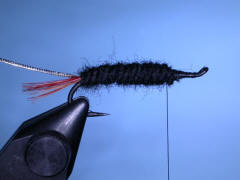|
Fly of
the Month
Bob Ireton brings together his
experience in fly fishing, aquatic entomology, and knowledge of fly
tying techniques and materials, to design and tie durable and
effective flies.
|

|

Volume 6, Issue 2
February 2005

SKUNK
Fly, Text, and Photography by Bob Ireton
This is a traditional Steelhead pattern
from the 1930’s. The exact origins are lost, but it appears that the
Skunk originated on the Stillaguamish and/or the Umpqua Rivers in the
Pacific Northwest of the United States. A couple good variations are the
Red Butt Skunk, and the Green Butt Skunk. This pattern continues to be
one of the most popular Steelhead fly patterns in use.
I happened to have a piece of polar bear,
and black bear skin in my tying materials stash, so I decided to tie
this old pattern using materials that the original tyers would have
used. Except for the tinsel, I think I have succeeded. I found the polar
bear hair to be difficult to stack, and the bulk leaves the head a bit
fuller than I like. Some flies may have been tied using skunk hair, but
the name comes from the combination of ‘white over black’, like the
markings of the skunk.
MATERIALS
Hook – TMC 7999, Daiichi 2441,
Dai-Riki 710, Orvis 1645, Mustad 36890.
Size – 2-8.
Thread – Black UNI 3/0 and 6/0.
Weight - .025 Lead wire.
Tail – Natural red feather fibers from a Golden Pheasant skin.
Rib – Medium Silver Tinsel.
Body – Black wool.
Under wing – Natural Black Bear hair.
Over wing – Natural Polar Bear hair.
Beard – Black hen cape hackle feather fibers.
TYING STEPS - click on
pictures for larger view
|
1 – Place the hook properly in the vice.
Steelhead are large, and strong fish, so use your discretion as to
weather or not you mash down the barb. Attach the 3/0 thread behind the
eye of the hook. I like to use 3/0 for the base of larger flies because
it covers faster. Lay down a good base rearward, stopping above the
barb. Add the weighted wire to the center half of the shank. Now form a
ramp on both ends of the lead wraps, and cover the lead with the thread.
Anywhere on the shank, tie a half hitch, then a whip finish. Snip off
the working 3/0 thread, and coat the thread with Dave’s fleximent. |
 |
| 2 – Attach the 6/0 working
thread above the hook barb. Now take a bunch of the tailing fibers, even
up the tips, and tie them in, making the length of the tail 1/3 to 1/2
the length of the hook shank. Snip off the excess fibers, and tie a half
hitch. |
 |
3 – Tie in a piece of medium tinsel for the
rib. Tie a half hitch.
|
 |
| 4 – Above the barb, form a
dubbing loop, then bring the working thread forward, and tie a half
hitch. Spread some wool evenly in the thread loop. The dubbing will be
less likely to snag on the hook if you can rotate the point of the hook
somewhat away from you. |
 |
|
5 – Continue to rotate the hook until the
point is on the opposite side from you. This will make spinning the loop
easier. Now spin the loop containing the wool to form a tight dubbing
rope. |
 |
|
6 –Palmer the completed dubbing rope
forward, forming a tight body. Stop the space of several hook eyes back,
so there will be room for the wing. Secure the dubbing rope with several
wraps of the thread, and cut off the excess dubbing rope. Trim off any
excess stray fibers on the completed dubbing rope body. Tie a half
hitch. |
 |
|
7 – Counter wrap the ribbing so it will not
slide between the wraps of the dubbing rope. Secure the rib, and cut off
the excess. Tie a half hitch. |
 |
8 – Cut a bunch of the black bear hair, and
stack it so the tips are even. Tie it in so the length of the under wing
is a little longer than the body of the fly. Snip off the excess hair,
and secure with several more wraps of thread. Tie a half hitch.
n wraps of thread. Tie a half hitch or two.
|
 |
|
9 – Now cut a bunch of the polar bear hair.
( If you don’t have polar bear hair, use a substitute, such as buck
tail, calf tail, etc.) The polar bear hair is a real ‘bear’ to work
with. Comb out the underfur, and even up the tips of the hair the best
way you can. I wound up stacking several hairs at a time to get enough.
Lay the polar bear hair over the black bear hair, and tie in. This hair
is so bulky, you will wind up with a chunky head. Snip off the excess,
and cover the butts with eve |
 |
|
10 – Select a bunch of the feather fibers
for the beard, and even up the tips. Hold on the underside of the fly,
and tie in. Snip off the excess ends. Even out the head, and tie a half
hitch. Then tie a whip finish, and snip off the working thread. Coat the
head with head cement. To make the head more durable, you could coat the
thread with ‘Hard Head |
 |
© 2005 Robert R. Ireton, II
www.buckeyeflyfishers.com
Site designed and maintained by
Panfalone@fuse.net
|










